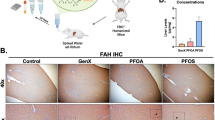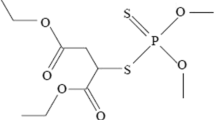Abstract
An assessment of the health status of ecosystems exposed to man-made pollution is a vital issue for many countries. Particularly it concerns the consequences of contamination caused by the activity of the space industry. Each rocket launch is accompanied by the introduction of parts of the rocket propellant into the environment. This study aims to scrutinize the effect of the components of rocket fuel on the induction of lipid peroxidation and chromosomal aberrations on rodents inhabiting the area exposed to pollution from Baikonur cosmodrome. The results showed the increase of the level of lipid hydroperoxide and malondialdehyde in the livers of Citellus pygmaeus Pallas and Mus musculus L., which indicates an augmentation of free radical activity and DNA damage. The cytogenetic analysis of bone marrow cells revealed that the frequency of chromosomal aberrations was a few times higher in the rodents from contaminated territory. The signs of oxidative stress and high level of chromosomal aberrations indicate the environmental impact of the cosmodrome, and its possible toxic and mutagenic effects on ecosystems.






Similar content being viewed by others
Abbreviations
- UDMH:
-
Unsymmetrical dimethyl hydrazine
- NDMA:
-
Nitrosodimethylamine
- ROS:
-
Reactive oxygen species
- LHP:
-
Lipid hydroperoxide
- MDA:
-
Malondialdehyde
- NO:
-
Nitric oxide
- PLO:
-
Product of lipid oxidation
- SH-group:
-
Sulfhydryl group
References
Albino AP, Huang X et al (2006) Induction of DNA double-strand breaks in A549 and normal human pulmonary epithelial cells by cigarette smoke is mediated by free radicals. Int J Oncol 28(6):1491–1505
Almeida AM (2006) Mitochondrial DNA damage associated with lipid peroxidation of the mitochondrial membrane induced by Fe2+ -citrate. An Acad Bras Cienc 78(3):505–514
Ayas S, Poblete P et al (2000) Porphyria cutanea tarda: frequency of mutations in the hemochromatosis and uroporphyrinogen decarboxylase gene in patients from germany and its implications for public health services. J Investig Dermatol 115(3):585
Batyrbekova S, Kenessov B et al (2008) Environmental monitoring of territories of “Baikonur” cosmodrome polluted with highly toxic rocket fuel components. Abstracts of Papers of the American Chemical Society, vol 236
Beauchamp NJ, Taybert J et al (2007) High frequency of missense mutations in glycogen storage disease type VI. J Inherit Metab Dis 30(5):722–734
Bennett MR (2001) Reactive oxygen species and death—oxidative DNA damage in atherosclerosis. Circ Res 88(7):648–650
Brunelli L, Yermilov V et al (2001) Modulation of catalase peroxidatic and catalatic activity by nitric oxide. Free Radical Biol Med 30(7):709–714
Bryant HE (2012) DNA double-strand break damage and repair assessed by pulsed-field gel electrophoresis. Methods Mol Biol 920:315–321
Byr’ka AA, Bogolitsyn KG et al (2010) Application of analytical methods for estimating contamination of atmospheric air during launch of carrier rockets of different classes from the Plesetsk Cosmodrome. Inorg Mater 46(15):1627–1631
Carlsen L, Kenessov BN et al (2009) Assessment of the mutagenic effect of 1,1-dimethyl hydrazine. Environ Toxicol Phar 28(3):448–452
Chugunov VA, Martovetskaya II et al (2000) Microbiological degradation of asymmetric dimethylhydrazine, a toxic rocket fuel ingredient. Appl Biochem Microbiol 36(6):544–549
Cole A, Meyn RE et al (1979) Relative contribution of unrepaired single-strand and double strand DNA breaks to biological damage. Biophys J 25(2):A155–A155
Cotman M, Zagorc-Koncan J (2005) Risk assessment approaches for ecosystem responses to a point source of pollution on receiving waters. River Basin Manag III 83:315–324
De Felice FG, Ferreira ST et al (2007) Soluble AE A beta oligomers induce tau hyperphosphorylation and NMDA receptor-mediated oxidative stress. J Neurochem 102:19
Devi GS, Prasad MH et al (2000) Free radicals antioxidant enzymes and lipid peroxidation in different types of leukemias. Clin Chim Acta 293(1–2):53–62
Dickens BF, Kramer JH et al (1988) Free-radicals, calcium, and membrane lipid-peroxidation. Faseb J 2(4):A834–A834
Ellis JB (2000) Risk assessment approaches for ecosystem responses to transient pollution events in urban receiving waters. Chemosphere 41(1–2):85–91
Erickson ED, Johnson JH et al (1989) Pollution problems from ordnance. 3. Study of the organic contaminants released to the environment during the disposal of rocket motors by burning. J Hazard Mater 21(2):161–176
Ferrari CKB (2000) Free radicals, lipid peroxidation and antioxidants in apoptosis: implications in cancer, cardiovascular and neurological diseases. Biologia 55(6):581–590
Gamper-Rabindran S, Finger SR (2013) Does industry self-regulation reduce pollution? Responsible care in the chemical industry. J Regul Econ 43(1):1–30
Gaschak SP, Maklyuk YA et al (2011) Radiation ecology issues associated with murine rodents and shrews in the chernobyl exclusion zone. Health Phys 101(4):416–430
Ghaznavi DN (1999) “Effect of agricultural, municipal and industrial pollution on the Indus ecosystem.” Indus river: biodiversity, resources, Humankind: pp 42–46
Goodman J, Hochstein P (1977) Generation of free-radicals and lipid peroxidation by redox cycling of adriamycin and daunomycin. Biochem Biophys Res Commun 77(2):797–803
Hansard R, Maher BA et al (2011) Biomagnetic monitoring of industry-derived particulate pollution. Environ Pollut 159(6):1673–1681
Ismagliov ZR, Kerzentsev MA et al (2004) Oxidation of unsymmetrical dimethyl hydrazine over oxide and noble metal catalysts. Solution of environmental problems of production, storage and disposal of highly toxic rocket fuels. In: Defense industries: science and technology related to security: impact of conventional munitions on environment and population. NATO Science Series IV-Earth and Environmental Sciences, vol 44. Springer, Netherlands, pp 293–313
Kaplan DL, Kaplan AM (1985) Biodegradation of N-Nitrosodimethylamine in aqueous and soil systems. Appl Environ Microbiol 50(4):1077–1086
Kasimov NS, Grebenyuk VB et al (1996) The behavior of rocket-fuel components in soil, water, and plants. Eurasian Soil Sci 28(1):79–95
Kenessov B, Koziel J et al (2010) Screening of transformation products of 1,1-dimethylhydrazine in soils affected by hydrazine-based rocket fuel spills using solid phase microextraction coupled to gas chromatography–mass spectrometry. Abstracts of Papers of the American Chemical Society, vol 239
Kikugawa K, Kato T et al (1989) Fluorescent and cross-linked proteins formed by free-radical and aldehyde species generated during lipid oxidation. Lipofuscin Ceroid Pigment 266:345–357
Lebedeva LI, Skorova SV et al (1993) Possible mechanisms of chromosomal-aberrations. 6. Mitotic delay as a protective process—origin of spontaneous chromosome breaks. Genetika 29(11):1826–1831
Lipanov AM (2003) Historical survey of solid-propellant rocket development in Russia. J Propul Power 19(6):1067–1088
Liteplo RG, Meek ME (2001) N-nitrosodimethylamine: hazard characterization and exposure-response analysis. J Environ Sci Health Part C-Environ Carcinog Ecotoxicol Rev 19(1):281–304
Mahmoud KE, Shalahmetova T et al (2011) Combined effect of vanadium and nickel on lipid peroxidation and selected parameters of antioxidant system in liver and kidney of male rat. Afr J Biotechnol 10(79):18319–18325
Mahmoud KE, Shalahmetova TM et al (2012) Antioxidant biological effects of crude oil and its inorganic component (vanadium) in liver and kidney of rats. J Animal Vet Adv 11(5):124–131
Malaquias AC, Brasil AS et al (2009) The G allele at KRAS IVS4 + 92 is associated with higher frequency of congenital heart disease and severity of short stature in Noonan syndrome patients with PTPN11 mutations. Horm Res 72:462
Marnett LJ (1999) Lipid peroxidation—DNA damage by malondialdehyde. Mutat Res Fund Mol Mech Mutagen 424(1–2):83–95
Medina MH, Correa JA et al (2007) Micro-evolution due to pollution: possible consequences for ecosystem responses to toxic stress. Chemosphere 67(11):2105–2114
Nair J, Bartsch H (2003) Oxidative stress and lipid peroxidation-induced DNA damage in human metal storage diseases. Naunyn-Schmiedebergs Arch Pharmacol 367:R3–R3
Negi R, Pande D et al (2012) In vivo Oxidative DNA damage and lipid peroxidation as a biomarker of oxidative stress in preterm low-birthweight infants. J Trop Pediatr 58(4):326–328
Noll DM, Mason TM et al (2006) Formation and repair of interstrand cross-links in DNA. Chem Rev 106(2):277–301
Ogawa Y, Kobayashi T et al (2003) Radiation-induced reactive oxygen species formation prior to oxidative DNA damage in human peripheral T cells. Int J Mol Med 11(2):149–152
Parks JK, Smith TS et al (2001) Neurotoxic A beta peptides increase oxidative stress in vivo through NMDA-receptor and nitric-oxide-synthase mechanisms, and inhibit complex IV activity and induce a mitochondrial permeability transition in vitro. J Neurochem 76(4):1050–1056
Preston RJ, Dean BJ et al (1987) Mammalian in vivo cytogenetic assays—analysis of chromosome-aberrations in bone-marrow cells. Mutat Res 189(2):157–165
Qi XY (2010) Reactive oxygen species scavenging activities and inhibition on DNA oxidative damage of dimeric compounds from the oxidation of (−)−epigallocatechin-3-O-gallate. Fitoterapia 81(3):205–209
Romanov VI, Romanova RL (2003) Risk factors of negative impact on objects of the environment upon accidents during launches of rocket-space hardware. Cosm Res 41(5):494–501
Sal’nikova L, Chumachenko A et al. (2012) “Association study of the frequencies of spontaneous and induced chromosome aberrations in human lymphocytes.” Radiobiol Environ Secur, pp 187–198
Sanchez-Chardi A, Penarroja-Matutano C et al (2009) Bioaccumulation of metals and effects of a landfill in small mammals Part III: structural alterations. Environ Res 109(8):960–967
Schipler A, Iliakis G (2013) DNA double-strand-break complexity levels and their possible contributions to the probability for error-prone processing and repair pathway choice. Nucleic Acids Res 41(16):7589–7605
Schmedes A, Holmer G (1989) A new thiobarbituric acid (Tba) method for determining free malondialdehyde (Mda) and hydroperoxides selectively as a measure of lipid-peroxidation. J Am Oil Chem Soc 66(6):813–817
Schroder JL, Basta NT et al (2003) Ecotoxicological risks associated with land treatment of petrochemical wastes. I. Residual soil contamination and bioaccumulation by cotton rats (Sigmodon hispidus). J Toxicol Environ Health Part A 66(4):305–325
Seo YR (2012) Genomic approach for understanding the mutagenic and carcinogenic mechanisms of heavy metal nickel in terms of gene–environment interaction. Int J Mol Med 30:S65–S65
Shatalov DV (2003) The history of the beginning of the Russian Plesetsk cosmodrome. Hist Rocket Astronaut 25:137–144
Sigfrid LA, Cunningham JM et al (2003) Cytokines and nitric oxide inhibit the enzyme activity of catalase but not its protein or mRNA expression in insulin-producing cells. J Mol Endocrinol 31(3):509–518
Sun HM and Tian WJ (2012) “A review of impacts of oil pollution on coastal wetland ecosystem.” Progress in environmental science and engineering (Iceesd 2011), Pts 1–5 356–360: 2551–2554
Swart J (2013) Intra-industry trade and heterogeneity in pollution emission. J Int Trade Econ Dev 22(1):116–139
Takeuchi T, Nakajima M et al (1996) Relationship between the intracellular reactive oxygen species and the induction of oxidative DNA damage in human neutrophil-like cells. Carcinogenesis 17(8):1543–1548
Vargas VMF (2003) Mutagenic activity as a parameter to assess ambient air quality for protection of the environment and human health. Mutat Res Rev Mutat Res 544(2–3):313–319
Villain J (1996) A brief history of Baikonur. Acta Astronaut 38(2):131–138
Wardle EN (1990) Free-radicals and lipid-peroxidation in relation to pathophysiological mechanisms. Saudi Med J 11(3):181–186
Winczura A, Zdzalik D et al (2012) Damage of DNA and proteins by major lipid peroxidation products in genome stability. Free Radical Res 46(4):442–459
Woodruff RC, Thompson JN (1982) Genetic-factors that affect rates of spontaneous mutation and chromosome-aberrations in Drosophila melanogaster. Cytogenet Cell Genet 33(1–2):152–159
Yadav VB, Jha SK (2013) Status of trace and toxic elements pollution in creek ecosystem using TXRF method. J Radioanal Nucl Chem 295(3):1759–1762
Yamaguchi O (1975) Spontaneous occurrence of chromosome-aberrations in Drosophila melanogaster. Jpn J Genet 49(5):332–333
Yang R, Liu JH, et al (2006) “Toxic mechanism and protection of unsymmetrical dimethyl hydrazine (UDMH).” Proceedings of the 3rd International academic conference on environmental and occupational medicine, pp 132–134
Yardim-Akaydin S, Caliskan-Can E et al (2013) Lipid peroxidation and DNA damage in apnea patients with or without metabolic syndrome. Sleep Biol Rhythms 11(2):116–124
Yarmishko VT, Yarmishko MA et al (1999) Response of plants to highly toxic components of liquid-propellant rocket fuel. Russ J Ecol 30(6):435–439
Acknowledgments
The authors would like to thank Paul Bartlett for helping to write this article. The experimental work was supported by the Committee of Science Department of Education and Science of the Republic of Kazakhstan through the grants: ‘Induced mutagenesis in mammals and measures for decreasing its risk by using biologically active substances of natural origin’ (Grant number 0106RK00279, period of grant 2006–2008) and ‘Study of genotoxic effects of environmental pollutants on mammals’ (Grant number 0112RK00580, period of grant 2012–2014).
Conflict of interest
The authors disclose no conflict of interest.
Author information
Authors and Affiliations
Corresponding author
Rights and permissions
About this article
Cite this article
Kolumbayeva, S., Begimbetova, D., Shalakhmetova, T. et al. Chromosomal instability in rodents caused by pollution from Baikonur cosmodrome. Ecotoxicology 23, 1283–1291 (2014). https://doi.org/10.1007/s10646-014-1271-1
Accepted:
Published:
Issue Date:
DOI: https://doi.org/10.1007/s10646-014-1271-1




